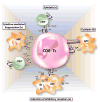Inhibitory CD8+ T cells in autoimmune disease
- PMID: 18812196
- PMCID: PMC2614126
- DOI: 10.1016/j.humimm.2008.08.283
Inhibitory CD8+ T cells in autoimmune disease
Abstract
Rheumatologists have long been focused on developing novel immunotherapeutic agents to manage such prototypic autoimmune diseases as rheumatoid arthritis (RA) and systemic lupus erythematosus (SLE). The ultimate challenge in providing immunosuppressive treatment for patients with RA and SLE has derived from the dilemma that both protective and harmful immune responses result from adaptive immune responses, mediated by highly diverse, antigen-specific T and B cells endowed with powerful effector functions and the ability for long-lasting memory. As regulatory/suppressor T cells can suppress immunity against any antigen, including self-antigens, they emerge as an ideal therapeutic target. Several distinct subtypes of CD8(+) suppressor cells (Ts) have been described that could find application in treating RA or SLE. In a xenograft model of human synovium, CD8(+)CD28(-)CD56(+) T cells effectively suppressed rheumatoid inflammation. Underlying mechanisms involve conditioning of antigen presenting cells (APC). Adoptively transferred CD8(+) T cells characterized by IL-16 secretion have also exhibited disease-inhibitory effects. In mice with polyarthritis, CD8(+) Ts suppressed inflammation by IFNgamma-mediated modulation of the tryptophan metabolism in APC. In SLE animal models, CD8(+) Ts induced by a synthetic peptide exerted suppressive activity mainly via the TGFbeta-Foxp3-PD1 pathway. CD8(+) Ts induced by histone peptides were found to downregulate disease activity by secreting TGFbeta. In essence, disease-specific approaches may be necessary to identify CD8(+) Ts optimally suited to treat immune dysfunctions in different autoimmune syndromes.
Figures



References
-
- Sakaguchi S, Sakaguchi N, Asano M, Itoh M, Toda M. Immunologic self-tolerance maintained by activated T cells expressing IL-2 receptor alpha-chains (CD25). Breakdown of a single mechanism of self-tolerance causes various autoimmune diseases. J Immunol. 1995;155:1151. - PubMed
-
- Rouse BT. Regulatory T cells in health and disease. J Intern Med. 2007;262:78. - PubMed
-
- Valencia X, Lipsky PE. CD4+CD25+FoxP3+ regulatory T cells in autoimmune diseases. Nat Clin Pract Rheumatol. 2007;3:619. - PubMed
Publication types
MeSH terms
Substances
Grants and funding
LinkOut - more resources
Full Text Sources
Other Literature Sources
Medical
Research Materials
Miscellaneous

